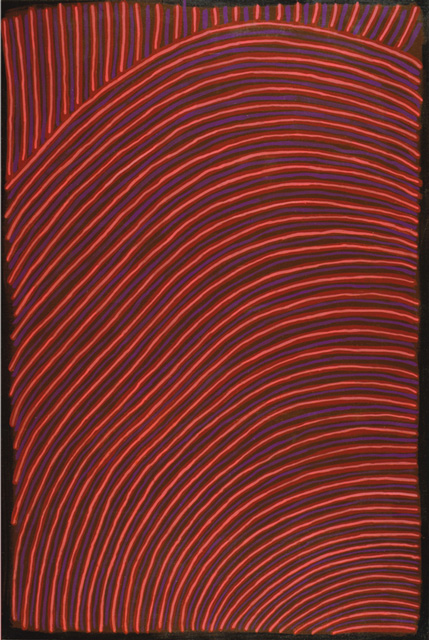


Gloria Petyarr, whose language is Anmatyerr, is from Utopia, approximately 240 kilometres north-east of Alice Springs in the Northern Territory. She is one of seven sisters, all of whom are artists, including Kathleen Petyarr and Ada Bird Petyarr. Along with several other Anmatyerr women, including Emily Kam Kngwarray, in 1977 Petyarr began painting ceremonial designs on silk batik as part of an adult education course. These works were widely exhibited abroad, including as part of a travelling exhibition of the Holmes à Court collection. In the late 1980s several of the women began painting on canvas, swiftly gaining reputations for producing some of the most exciting contemporary Australian art of the early 1990s.
The Petyarr sisters share the same custodial responsibilities for their country, and also the ceremonial dances, songs, stories and designs which that involves. As in the works of her sister Kathleen Petyarr, Gloria's principal subject is arnkerrnth, the mountain devil lizard, a small, spiky chameleon-like creature that moves in a semi-circular fashion, leaving a trail of tiny concentric tracks.1 Like her great friend, Emily Kam Kngwarray, Gloria has described her work as being 'awelye', which has been translated roughly as meaning 'the whole lot' —a complex yet cryptic explanation which at once embraces a universe of Aboriginal knowledge and throws viewers back on their own perceptions. Awelye also refers to ceremonial body painting, and, as Christopher Hodges has pointed out, the designs that are painted on the body also constitute a body of knowledge.2 Lizards, snakes, centipedes and goannas; footprints, animal tracks, sites and implements; leaves, seeds and flowers:3 intimate knowledge of the desert combines seamlessly with the demands of abstraction and the canvas in works that are as beautiful as they are (to those unversed in their specific lore) opaque.
Unlike Kngwarray, who more or less moved through a progression of styles (with aberrations), Petyarr works simultaneously in several, disparate styles, producing works so diverse it is hard to believe they are by the same hand. Body design (1997) is an example of works based on the designs of body painting. Unlike Petyarr's earlier works, in which designs intended for the body were transferred 'as if lifted off the body and applied to the canvas'4, the enlargement of this thumbprint-like image suggests a design thought out in terms of canvas rather than the body. The vibrant collision of closely related colours lends a vivacity to the image, filling the picture plane with an energy and authority commensurate with the confidence of an artist of Petyarr's seniority. More recently, Petyarr has evolved a feathery style of painting in which she invokes the effects of wind on the grasses and leaves of the desert—remarkable canvases which, in their return to the shimmering movement of silk, breathe the life of her country.
- Hannah Fink
Gloria Petyarre is represented in Australia by Utopia Art Sydney, Sydney.